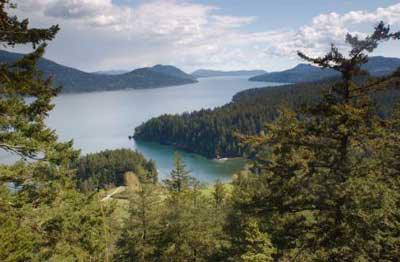by Emily Greenberg
Journal Reporter
Every county in Washington state has the ability to elect in a land bank – but San Juan is the only county to do it.
“People here have a clear understanding how important the natural environment is to the community as a whole,” said Lincoln Bormann, director of the San Juan County Land Bank. “If we lose that we’ll become just like everywhere else.”
This year, 2015, marks 25 years of conservation efforts at the land bank, and the celebration is ongoing. A little history first.
The land bank got its start in 1990 when a group of citizens became concerned over the quickening pace of development across the islands. The big idea was to conserve as much open space as possible.
The land bank works by the outright purchase of land to ensure its preservation, or by conservation easements, another mechanism to protect open space. Funded in large part through a 1-percent real estate excise tax, the land bank also has the ability to obtain state and federal grants.
In a conservation easement the landowner retains ownership, but the land bank buys rights to reduce the amount of development allowed on that land. Those dividends are paid to the landowners.
This transaction allows “fields to remain fields, and farms to remain farms,” Bormann said.
Over the last two decades the land bank has made great strides in preserving land on San Juan, Orcas and Lopez Islands, with more than 20 preserves open to the public – but it takes a village to preserve all that land. The synergy between the land bank and non-county run organizations, like the San Juan Preservation Trust and National Park Service, is what also helps make for successful ventures in conservation.
Milestones
In 2006, the Washington State Department of Natural Resources considered strongly the possibility of selling San Juan Island’s Mitchell Hill to a private developer.
When the community got wind of it, opposition arose and the National Parks Service also wanted to acquire the land. But without the opportunity for funding, the parks service was at a stalemate. The land bank, bolstered by a federal grant, purchased the 385-acre Hill and then bequeathed it to the National Parks Service and it became part of English Camp.
But the Land Bank is not always the hero coming to the rescue in times of conservation crisis. Also in 2006, Orcas Island’s Turtleback Mountain came close to becoming the site of 40 to 80 new homes. Through a collaboration with the preservation trust and funds acquired through private donations, the land bank was able to purchase the land. The trust has conservation easements on the land.
What is now the 1,600-acre Turtleback Mountain Preserve may not have come to pass if not for the efforts of both organizations.
“Independently, neither organization could have done it,” Bormann said.
The creation of the Watmough Bay Preserve on Lopez Island is yet another example of the benefit of the partnership of the land bank/preservation trust partnership. A section of the beach was donated to the land bank in 1993, and a conservation easement was later added to an adjacent eight acres of wetlands. The surrounding 390 acres were purchased by the Bureau of Land Management and designated as an “area of critical environmental concern.”
The land bank and preservation trust acquired the two remaining developable lots in 2007, essentially in the middle of the protected area, to complete the preserve.
The remaining lots were purchased by the land bank with funds from a federal salmon recovery grant and with the help of private donations to the trust.
Twenty-five years
The 25th anniversary will be marked by an acquisition of another high-profile piece of property on San Juan Island. Lawson Ridge, located off of Beaverton Valley Road, has been on the market for more than a year and was to be sold as a residential subdivision, with roads, power and water already in place.
In partnership with other conservation organizations, the land bank expects to close on its pending purchase of Lawson Ridge in March, and then open it to the public a few weeks after. Documents dating as far back as 1875 refer to the area as Mount Grant, Bormann said, and the agency intends to rename Lawson Ridge as Mount Grant Preserve, which features stunning vistas of the San Juan Valley and affords access to hikers and automobiles as well.
The land bank is also organizing a first-ever Poetry Trail on several of its preserves and neighboring parks. Limekiln and Deadman Bay preserves, Lime Kiln Point State Park and American Camp will display open-space-inspired poems from islanders throughout the month of April.
The land bank also works to help protect and strengthen and re-introduce native plants in the islands. The agency will host a seed-collector training in late June for anyone interested in helping with native plant restoration.
For more information about Land Bank events and preserves, visit www.sjclandbank.org.



